Auditing and Assurance Report: Financial Statement Analysis and Audit
VerifiedAdded on 2022/09/16
|11
|3604
|22
Report
AI Summary
This report provides an in-depth analysis of auditing and assurance issues encountered by Computing Solutions Limited and Beautiful Hair Ltd. It examines key audit matters and substantive procedures related to inventory valuation at Computing Solutions and the recognition of intangible assets (intellectual property) at Beautiful Hair Ltd. The report addresses specific audit assertions, including completeness and accuracy, and outlines the procedures auditors should undertake to mitigate risks associated with these assertions. Furthermore, it discusses the application of ASA 701 in communicating key audit matters, providing a detailed framework for addressing audit concerns and ensuring the reliability of financial statements. The report offers practical recommendations and insights into the complexities of auditing in these scenarios.
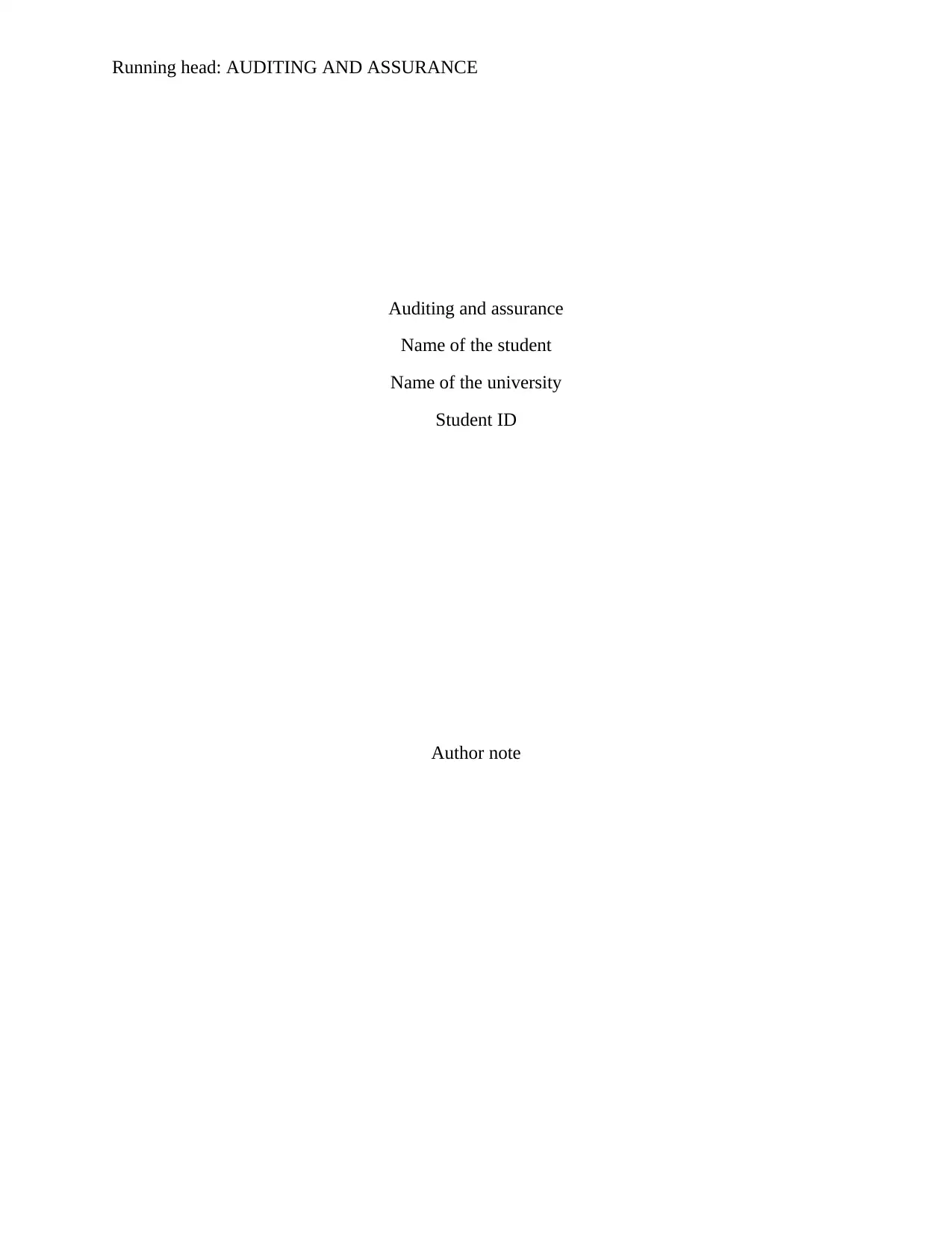
Running head: AUDITING AND ASSURANCE
Auditing and assurance
Name of the student
Name of the university
Student ID
Author note
Auditing and assurance
Name of the student
Name of the university
Student ID
Author note
Paraphrase This Document
Need a fresh take? Get an instant paraphrase of this document with our AI Paraphraser
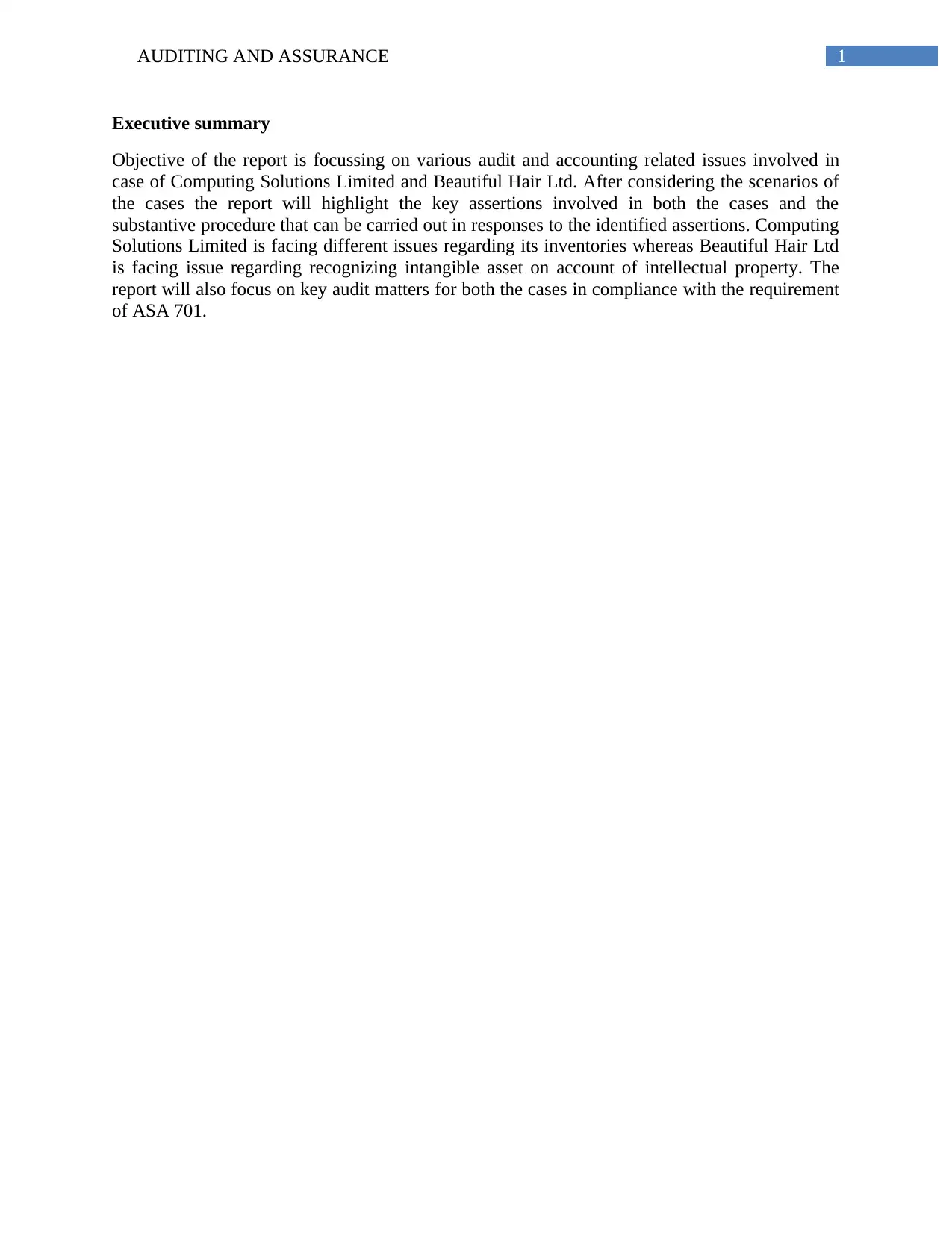
1AUDITING AND ASSURANCE
Executive summary
Objective of the report is focussing on various audit and accounting related issues involved in
case of Computing Solutions Limited and Beautiful Hair Ltd. After considering the scenarios of
the cases the report will highlight the key assertions involved in both the cases and the
substantive procedure that can be carried out in responses to the identified assertions. Computing
Solutions Limited is facing different issues regarding its inventories whereas Beautiful Hair Ltd
is facing issue regarding recognizing intangible asset on account of intellectual property. The
report will also focus on key audit matters for both the cases in compliance with the requirement
of ASA 701.
Executive summary
Objective of the report is focussing on various audit and accounting related issues involved in
case of Computing Solutions Limited and Beautiful Hair Ltd. After considering the scenarios of
the cases the report will highlight the key assertions involved in both the cases and the
substantive procedure that can be carried out in responses to the identified assertions. Computing
Solutions Limited is facing different issues regarding its inventories whereas Beautiful Hair Ltd
is facing issue regarding recognizing intangible asset on account of intellectual property. The
report will also focus on key audit matters for both the cases in compliance with the requirement
of ASA 701.
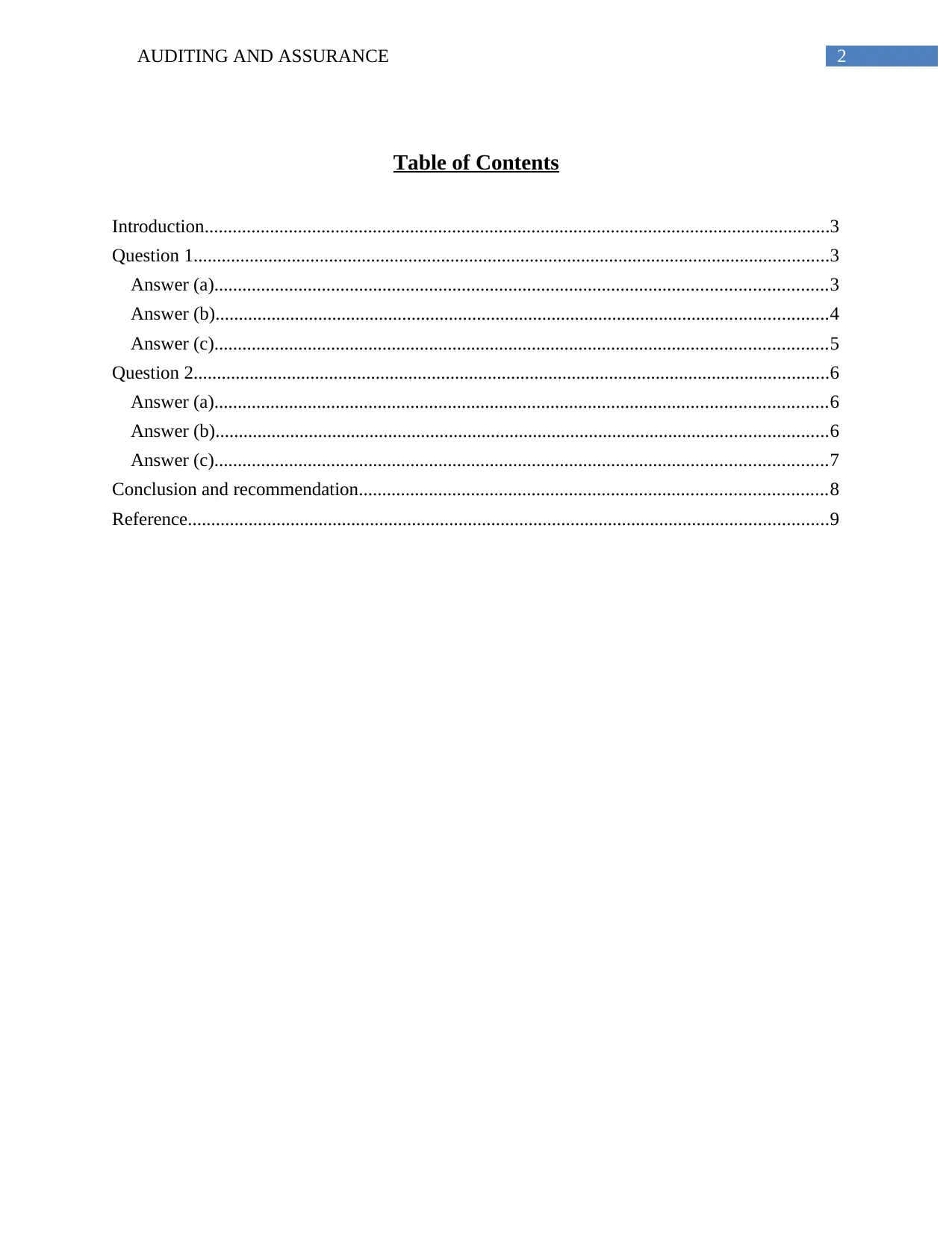
2AUDITING AND ASSURANCE
Table of Contents
Introduction......................................................................................................................................3
Question 1........................................................................................................................................3
Answer (a)...................................................................................................................................3
Answer (b)...................................................................................................................................4
Answer (c)...................................................................................................................................5
Question 2........................................................................................................................................6
Answer (a)...................................................................................................................................6
Answer (b)...................................................................................................................................6
Answer (c)...................................................................................................................................7
Conclusion and recommendation....................................................................................................8
Reference.........................................................................................................................................9
Table of Contents
Introduction......................................................................................................................................3
Question 1........................................................................................................................................3
Answer (a)...................................................................................................................................3
Answer (b)...................................................................................................................................4
Answer (c)...................................................................................................................................5
Question 2........................................................................................................................................6
Answer (a)...................................................................................................................................6
Answer (b)...................................................................................................................................6
Answer (c)...................................................................................................................................7
Conclusion and recommendation....................................................................................................8
Reference.........................................................................................................................................9
⊘ This is a preview!⊘
Do you want full access?
Subscribe today to unlock all pages.

Trusted by 1+ million students worldwide
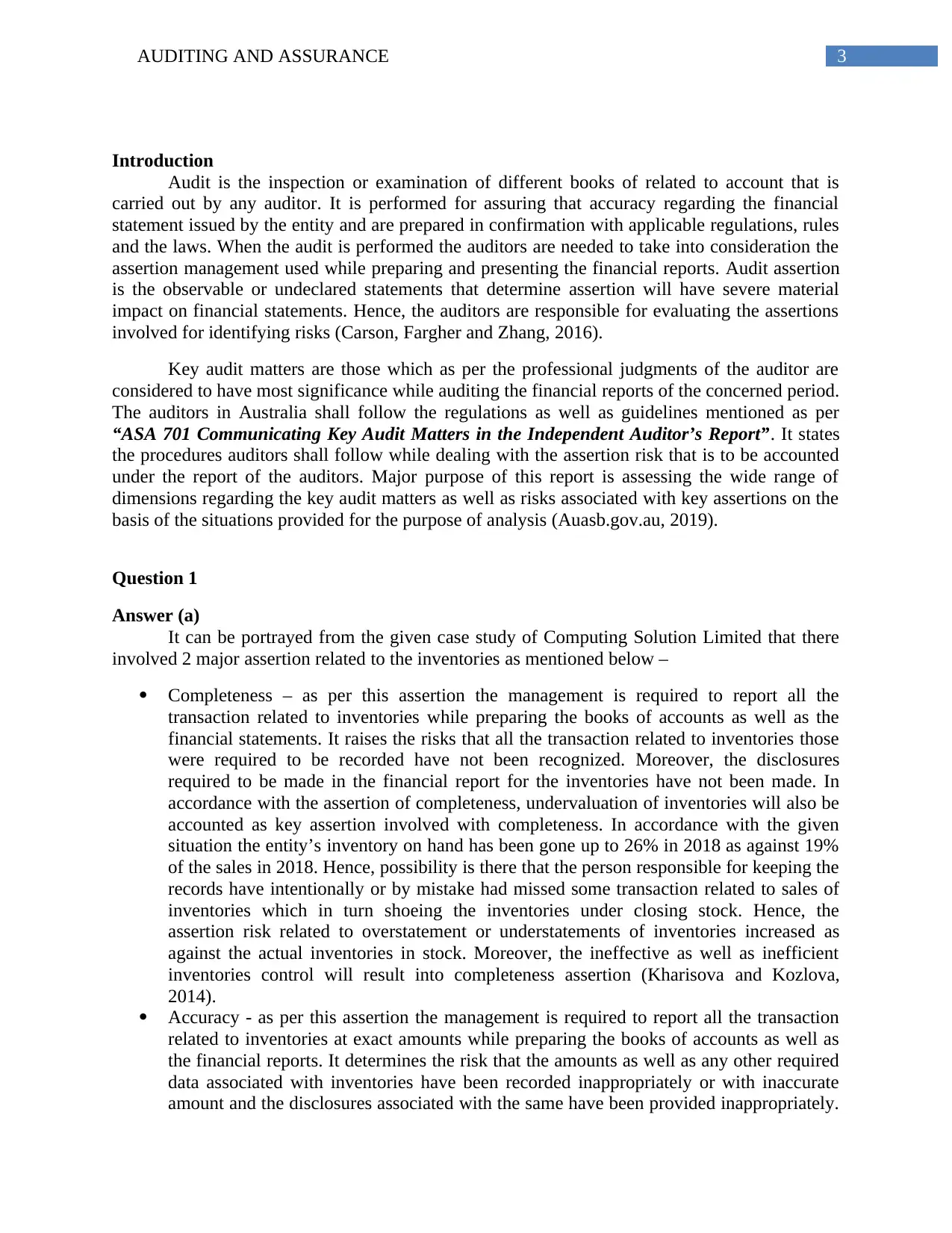
3AUDITING AND ASSURANCE
Introduction
Audit is the inspection or examination of different books of related to account that is
carried out by any auditor. It is performed for assuring that accuracy regarding the financial
statement issued by the entity and are prepared in confirmation with applicable regulations, rules
and the laws. When the audit is performed the auditors are needed to take into consideration the
assertion management used while preparing and presenting the financial reports. Audit assertion
is the observable or undeclared statements that determine assertion will have severe material
impact on financial statements. Hence, the auditors are responsible for evaluating the assertions
involved for identifying risks (Carson, Fargher and Zhang, 2016).
Key audit matters are those which as per the professional judgments of the auditor are
considered to have most significance while auditing the financial reports of the concerned period.
The auditors in Australia shall follow the regulations as well as guidelines mentioned as per
“ASA 701 Communicating Key Audit Matters in the Independent Auditor’s Report”. It states
the procedures auditors shall follow while dealing with the assertion risk that is to be accounted
under the report of the auditors. Major purpose of this report is assessing the wide range of
dimensions regarding the key audit matters as well as risks associated with key assertions on the
basis of the situations provided for the purpose of analysis (Auasb.gov.au, 2019).
Question 1
Answer (a)
It can be portrayed from the given case study of Computing Solution Limited that there
involved 2 major assertion related to the inventories as mentioned below –
Completeness – as per this assertion the management is required to report all the
transaction related to inventories while preparing the books of accounts as well as the
financial statements. It raises the risks that all the transaction related to inventories those
were required to be recorded have not been recognized. Moreover, the disclosures
required to be made in the financial report for the inventories have not been made. In
accordance with the assertion of completeness, undervaluation of inventories will also be
accounted as key assertion involved with completeness. In accordance with the given
situation the entity’s inventory on hand has been gone up to 26% in 2018 as against 19%
of the sales in 2018. Hence, possibility is there that the person responsible for keeping the
records have intentionally or by mistake had missed some transaction related to sales of
inventories which in turn shoeing the inventories under closing stock. Hence, the
assertion risk related to overstatement or understatements of inventories increased as
against the actual inventories in stock. Moreover, the ineffective as well as inefficient
inventories control will result into completeness assertion (Kharisova and Kozlova,
2014).
Accuracy - as per this assertion the management is required to report all the transaction
related to inventories at exact amounts while preparing the books of accounts as well as
the financial reports. It determines the risk that the amounts as well as any other required
data associated with inventories have been recorded inappropriately or with inaccurate
amount and the disclosures associated with the same have been provided inappropriately.
Introduction
Audit is the inspection or examination of different books of related to account that is
carried out by any auditor. It is performed for assuring that accuracy regarding the financial
statement issued by the entity and are prepared in confirmation with applicable regulations, rules
and the laws. When the audit is performed the auditors are needed to take into consideration the
assertion management used while preparing and presenting the financial reports. Audit assertion
is the observable or undeclared statements that determine assertion will have severe material
impact on financial statements. Hence, the auditors are responsible for evaluating the assertions
involved for identifying risks (Carson, Fargher and Zhang, 2016).
Key audit matters are those which as per the professional judgments of the auditor are
considered to have most significance while auditing the financial reports of the concerned period.
The auditors in Australia shall follow the regulations as well as guidelines mentioned as per
“ASA 701 Communicating Key Audit Matters in the Independent Auditor’s Report”. It states
the procedures auditors shall follow while dealing with the assertion risk that is to be accounted
under the report of the auditors. Major purpose of this report is assessing the wide range of
dimensions regarding the key audit matters as well as risks associated with key assertions on the
basis of the situations provided for the purpose of analysis (Auasb.gov.au, 2019).
Question 1
Answer (a)
It can be portrayed from the given case study of Computing Solution Limited that there
involved 2 major assertion related to the inventories as mentioned below –
Completeness – as per this assertion the management is required to report all the
transaction related to inventories while preparing the books of accounts as well as the
financial statements. It raises the risks that all the transaction related to inventories those
were required to be recorded have not been recognized. Moreover, the disclosures
required to be made in the financial report for the inventories have not been made. In
accordance with the assertion of completeness, undervaluation of inventories will also be
accounted as key assertion involved with completeness. In accordance with the given
situation the entity’s inventory on hand has been gone up to 26% in 2018 as against 19%
of the sales in 2018. Hence, possibility is there that the person responsible for keeping the
records have intentionally or by mistake had missed some transaction related to sales of
inventories which in turn shoeing the inventories under closing stock. Hence, the
assertion risk related to overstatement or understatements of inventories increased as
against the actual inventories in stock. Moreover, the ineffective as well as inefficient
inventories control will result into completeness assertion (Kharisova and Kozlova,
2014).
Accuracy - as per this assertion the management is required to report all the transaction
related to inventories at exact amounts while preparing the books of accounts as well as
the financial reports. It determines the risk that the amounts as well as any other required
data associated with inventories have been recorded inappropriately or with inaccurate
amount and the disclosures associated with the same have been provided inappropriately.
Paraphrase This Document
Need a fresh take? Get an instant paraphrase of this document with our AI Paraphraser
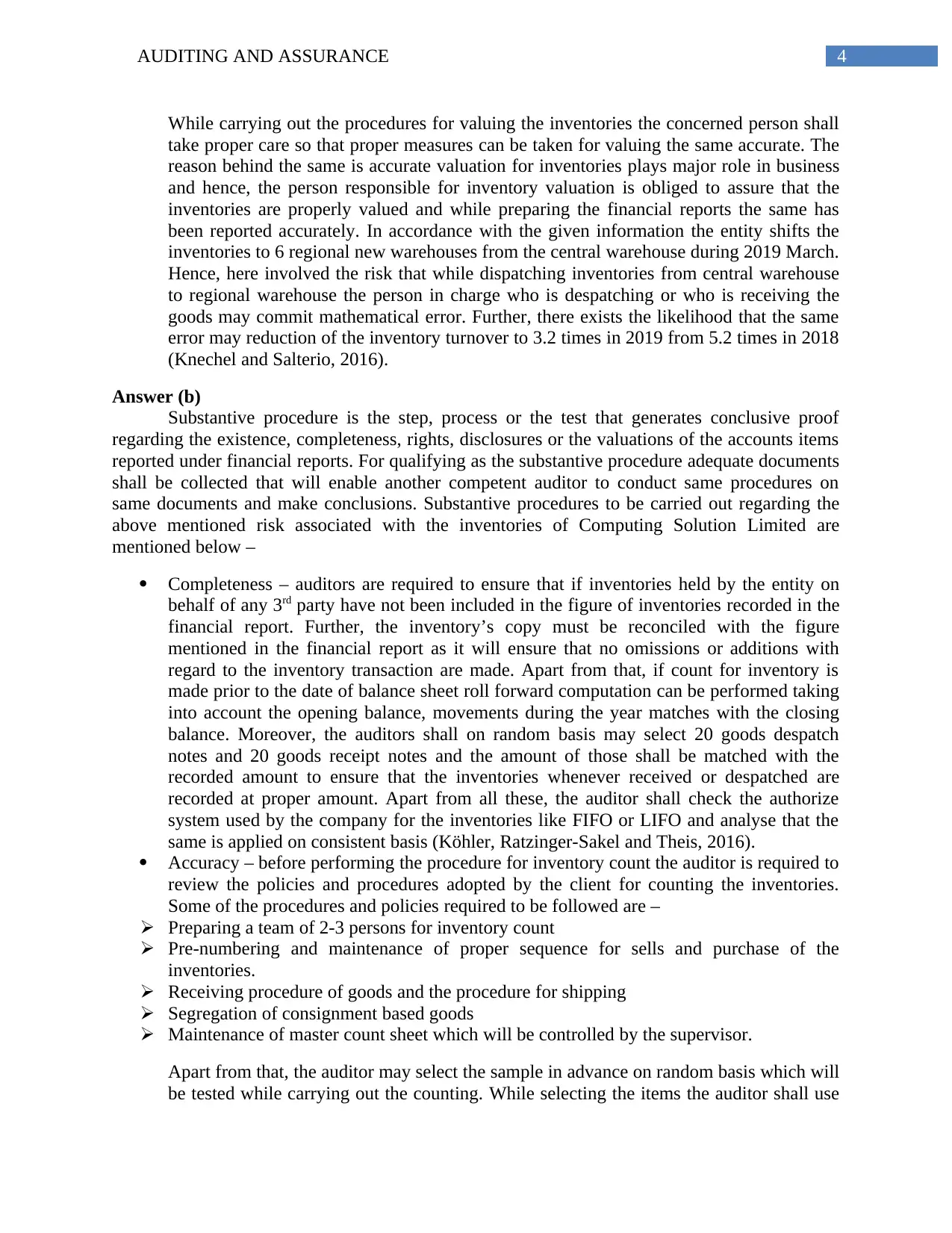
4AUDITING AND ASSURANCE
While carrying out the procedures for valuing the inventories the concerned person shall
take proper care so that proper measures can be taken for valuing the same accurate. The
reason behind the same is accurate valuation for inventories plays major role in business
and hence, the person responsible for inventory valuation is obliged to assure that the
inventories are properly valued and while preparing the financial reports the same has
been reported accurately. In accordance with the given information the entity shifts the
inventories to 6 regional new warehouses from the central warehouse during 2019 March.
Hence, here involved the risk that while dispatching inventories from central warehouse
to regional warehouse the person in charge who is despatching or who is receiving the
goods may commit mathematical error. Further, there exists the likelihood that the same
error may reduction of the inventory turnover to 3.2 times in 2019 from 5.2 times in 2018
(Knechel and Salterio, 2016).
Answer (b)
Substantive procedure is the step, process or the test that generates conclusive proof
regarding the existence, completeness, rights, disclosures or the valuations of the accounts items
reported under financial reports. For qualifying as the substantive procedure adequate documents
shall be collected that will enable another competent auditor to conduct same procedures on
same documents and make conclusions. Substantive procedures to be carried out regarding the
above mentioned risk associated with the inventories of Computing Solution Limited are
mentioned below –
Completeness – auditors are required to ensure that if inventories held by the entity on
behalf of any 3rd party have not been included in the figure of inventories recorded in the
financial report. Further, the inventory’s copy must be reconciled with the figure
mentioned in the financial report as it will ensure that no omissions or additions with
regard to the inventory transaction are made. Apart from that, if count for inventory is
made prior to the date of balance sheet roll forward computation can be performed taking
into account the opening balance, movements during the year matches with the closing
balance. Moreover, the auditors shall on random basis may select 20 goods despatch
notes and 20 goods receipt notes and the amount of those shall be matched with the
recorded amount to ensure that the inventories whenever received or despatched are
recorded at proper amount. Apart from all these, the auditor shall check the authorize
system used by the company for the inventories like FIFO or LIFO and analyse that the
same is applied on consistent basis (Köhler, Ratzinger-Sakel and Theis, 2016).
Accuracy – before performing the procedure for inventory count the auditor is required to
review the policies and procedures adopted by the client for counting the inventories.
Some of the procedures and policies required to be followed are –
Preparing a team of 2-3 persons for inventory count
Pre-numbering and maintenance of proper sequence for sells and purchase of the
inventories.
Receiving procedure of goods and the procedure for shipping
Segregation of consignment based goods
Maintenance of master count sheet which will be controlled by the supervisor.
Apart from that, the auditor may select the sample in advance on random basis which will
be tested while carrying out the counting. While selecting the items the auditor shall use
While carrying out the procedures for valuing the inventories the concerned person shall
take proper care so that proper measures can be taken for valuing the same accurate. The
reason behind the same is accurate valuation for inventories plays major role in business
and hence, the person responsible for inventory valuation is obliged to assure that the
inventories are properly valued and while preparing the financial reports the same has
been reported accurately. In accordance with the given information the entity shifts the
inventories to 6 regional new warehouses from the central warehouse during 2019 March.
Hence, here involved the risk that while dispatching inventories from central warehouse
to regional warehouse the person in charge who is despatching or who is receiving the
goods may commit mathematical error. Further, there exists the likelihood that the same
error may reduction of the inventory turnover to 3.2 times in 2019 from 5.2 times in 2018
(Knechel and Salterio, 2016).
Answer (b)
Substantive procedure is the step, process or the test that generates conclusive proof
regarding the existence, completeness, rights, disclosures or the valuations of the accounts items
reported under financial reports. For qualifying as the substantive procedure adequate documents
shall be collected that will enable another competent auditor to conduct same procedures on
same documents and make conclusions. Substantive procedures to be carried out regarding the
above mentioned risk associated with the inventories of Computing Solution Limited are
mentioned below –
Completeness – auditors are required to ensure that if inventories held by the entity on
behalf of any 3rd party have not been included in the figure of inventories recorded in the
financial report. Further, the inventory’s copy must be reconciled with the figure
mentioned in the financial report as it will ensure that no omissions or additions with
regard to the inventory transaction are made. Apart from that, if count for inventory is
made prior to the date of balance sheet roll forward computation can be performed taking
into account the opening balance, movements during the year matches with the closing
balance. Moreover, the auditors shall on random basis may select 20 goods despatch
notes and 20 goods receipt notes and the amount of those shall be matched with the
recorded amount to ensure that the inventories whenever received or despatched are
recorded at proper amount. Apart from all these, the auditor shall check the authorize
system used by the company for the inventories like FIFO or LIFO and analyse that the
same is applied on consistent basis (Köhler, Ratzinger-Sakel and Theis, 2016).
Accuracy – before performing the procedure for inventory count the auditor is required to
review the policies and procedures adopted by the client for counting the inventories.
Some of the procedures and policies required to be followed are –
Preparing a team of 2-3 persons for inventory count
Pre-numbering and maintenance of proper sequence for sells and purchase of the
inventories.
Receiving procedure of goods and the procedure for shipping
Segregation of consignment based goods
Maintenance of master count sheet which will be controlled by the supervisor.
Apart from that, the auditor may select the sample in advance on random basis which will
be tested while carrying out the counting. While selecting the items the auditor shall use
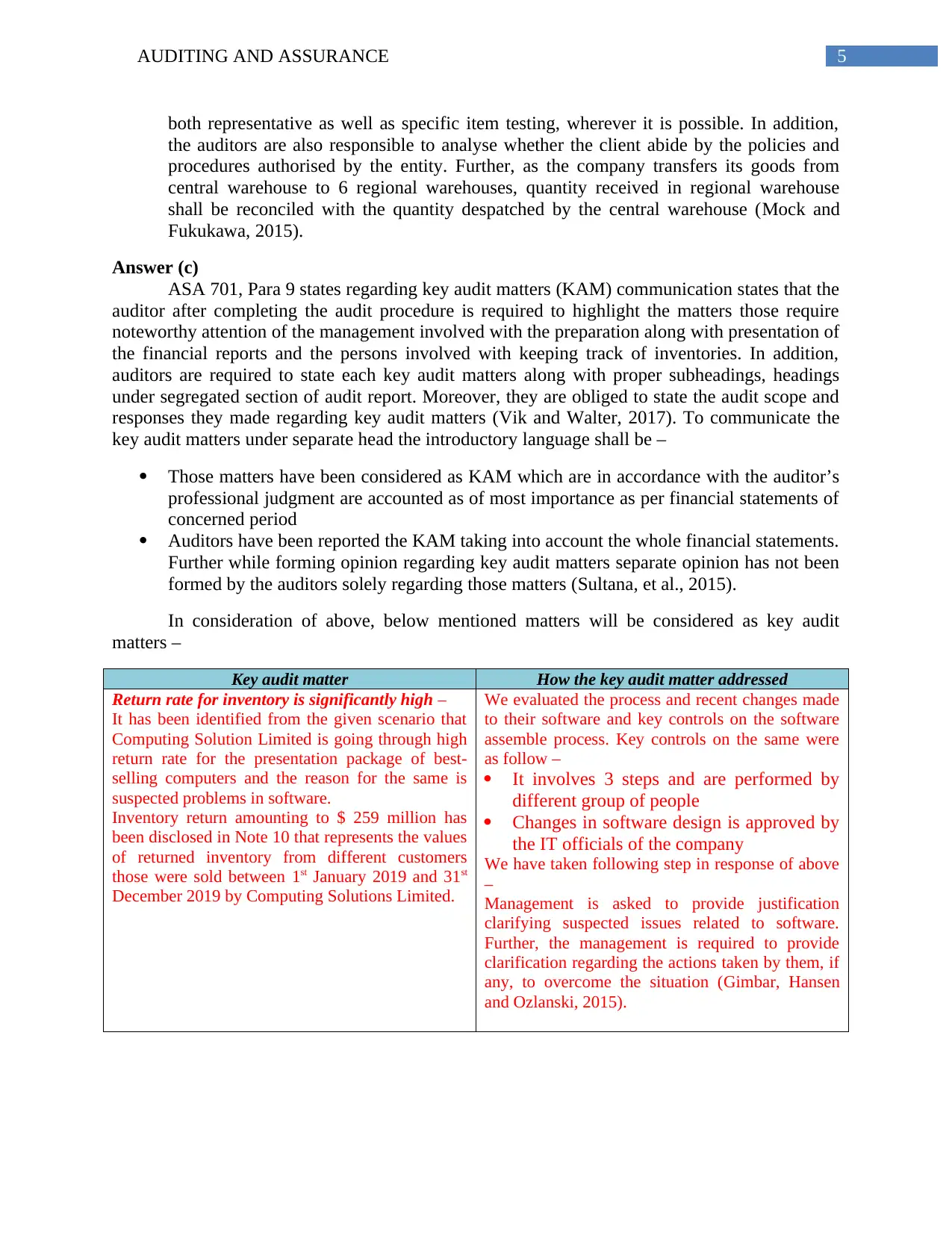
5AUDITING AND ASSURANCE
both representative as well as specific item testing, wherever it is possible. In addition,
the auditors are also responsible to analyse whether the client abide by the policies and
procedures authorised by the entity. Further, as the company transfers its goods from
central warehouse to 6 regional warehouses, quantity received in regional warehouse
shall be reconciled with the quantity despatched by the central warehouse (Mock and
Fukukawa, 2015).
Answer (c)
ASA 701, Para 9 states regarding key audit matters (KAM) communication states that the
auditor after completing the audit procedure is required to highlight the matters those require
noteworthy attention of the management involved with the preparation along with presentation of
the financial reports and the persons involved with keeping track of inventories. In addition,
auditors are required to state each key audit matters along with proper subheadings, headings
under segregated section of audit report. Moreover, they are obliged to state the audit scope and
responses they made regarding key audit matters (Vik and Walter, 2017). To communicate the
key audit matters under separate head the introductory language shall be –
Those matters have been considered as KAM which are in accordance with the auditor’s
professional judgment are accounted as of most importance as per financial statements of
concerned period
Auditors have been reported the KAM taking into account the whole financial statements.
Further while forming opinion regarding key audit matters separate opinion has not been
formed by the auditors solely regarding those matters (Sultana, et al., 2015).
In consideration of above, below mentioned matters will be considered as key audit
matters –
Key audit matter How the key audit matter addressed
Return rate for inventory is significantly high –
It has been identified from the given scenario that
Computing Solution Limited is going through high
return rate for the presentation package of best-
selling computers and the reason for the same is
suspected problems in software.
Inventory return amounting to $ 259 million has
been disclosed in Note 10 that represents the values
of returned inventory from different customers
those were sold between 1st January 2019 and 31st
December 2019 by Computing Solutions Limited.
We evaluated the process and recent changes made
to their software and key controls on the software
assemble process. Key controls on the same were
as follow –
It involves 3 steps and are performed by
different group of people
Changes in software design is approved by
the IT officials of the company
We have taken following step in response of above
–
Management is asked to provide justification
clarifying suspected issues related to software.
Further, the management is required to provide
clarification regarding the actions taken by them, if
any, to overcome the situation (Gimbar, Hansen
and Ozlanski, 2015).
both representative as well as specific item testing, wherever it is possible. In addition,
the auditors are also responsible to analyse whether the client abide by the policies and
procedures authorised by the entity. Further, as the company transfers its goods from
central warehouse to 6 regional warehouses, quantity received in regional warehouse
shall be reconciled with the quantity despatched by the central warehouse (Mock and
Fukukawa, 2015).
Answer (c)
ASA 701, Para 9 states regarding key audit matters (KAM) communication states that the
auditor after completing the audit procedure is required to highlight the matters those require
noteworthy attention of the management involved with the preparation along with presentation of
the financial reports and the persons involved with keeping track of inventories. In addition,
auditors are required to state each key audit matters along with proper subheadings, headings
under segregated section of audit report. Moreover, they are obliged to state the audit scope and
responses they made regarding key audit matters (Vik and Walter, 2017). To communicate the
key audit matters under separate head the introductory language shall be –
Those matters have been considered as KAM which are in accordance with the auditor’s
professional judgment are accounted as of most importance as per financial statements of
concerned period
Auditors have been reported the KAM taking into account the whole financial statements.
Further while forming opinion regarding key audit matters separate opinion has not been
formed by the auditors solely regarding those matters (Sultana, et al., 2015).
In consideration of above, below mentioned matters will be considered as key audit
matters –
Key audit matter How the key audit matter addressed
Return rate for inventory is significantly high –
It has been identified from the given scenario that
Computing Solution Limited is going through high
return rate for the presentation package of best-
selling computers and the reason for the same is
suspected problems in software.
Inventory return amounting to $ 259 million has
been disclosed in Note 10 that represents the values
of returned inventory from different customers
those were sold between 1st January 2019 and 31st
December 2019 by Computing Solutions Limited.
We evaluated the process and recent changes made
to their software and key controls on the software
assemble process. Key controls on the same were
as follow –
It involves 3 steps and are performed by
different group of people
Changes in software design is approved by
the IT officials of the company
We have taken following step in response of above
–
Management is asked to provide justification
clarifying suspected issues related to software.
Further, the management is required to provide
clarification regarding the actions taken by them, if
any, to overcome the situation (Gimbar, Hansen
and Ozlanski, 2015).
⊘ This is a preview!⊘
Do you want full access?
Subscribe today to unlock all pages.

Trusted by 1+ million students worldwide
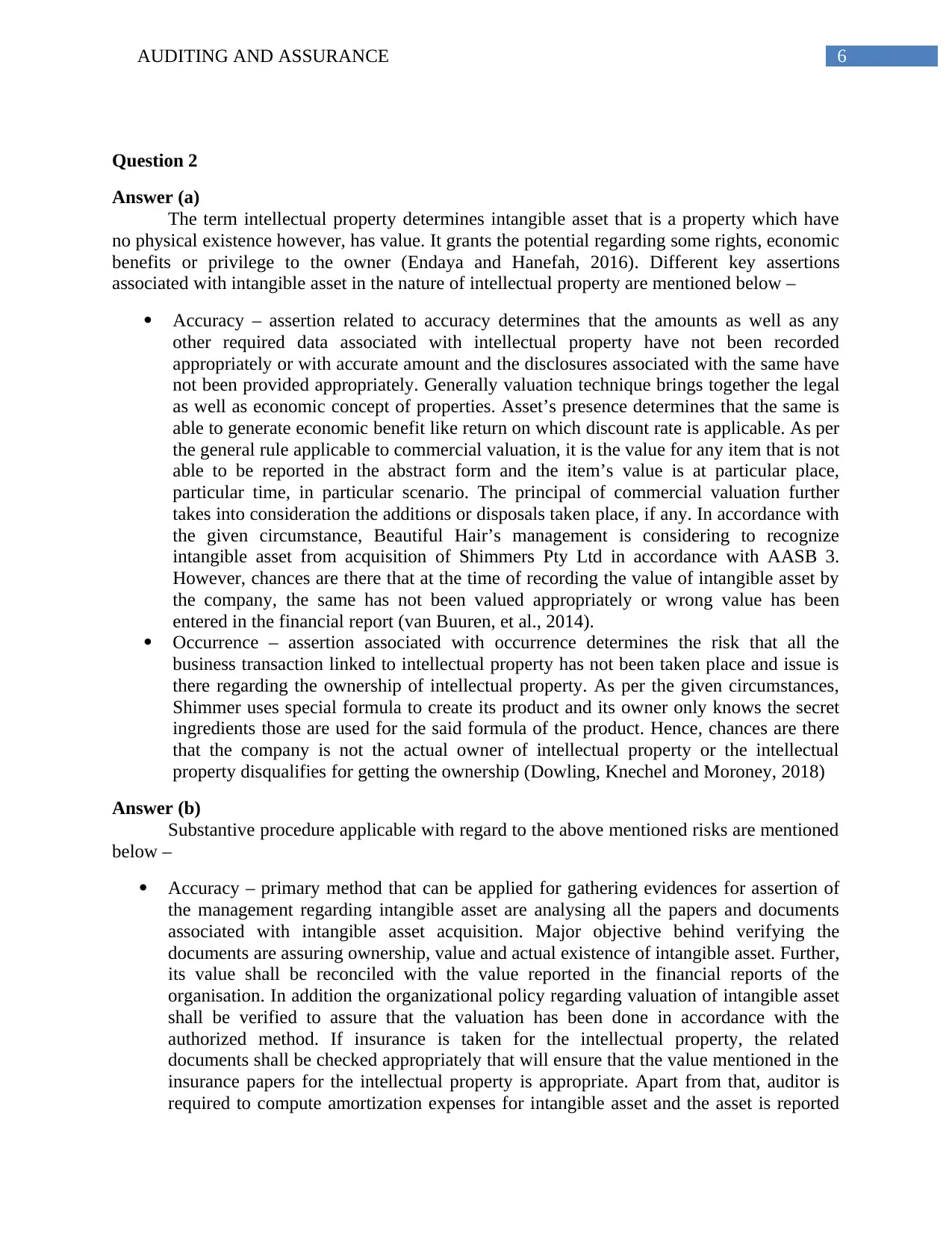
6AUDITING AND ASSURANCE
Question 2
Answer (a)
The term intellectual property determines intangible asset that is a property which have
no physical existence however, has value. It grants the potential regarding some rights, economic
benefits or privilege to the owner (Endaya and Hanefah, 2016). Different key assertions
associated with intangible asset in the nature of intellectual property are mentioned below –
Accuracy – assertion related to accuracy determines that the amounts as well as any
other required data associated with intellectual property have not been recorded
appropriately or with accurate amount and the disclosures associated with the same have
not been provided appropriately. Generally valuation technique brings together the legal
as well as economic concept of properties. Asset’s presence determines that the same is
able to generate economic benefit like return on which discount rate is applicable. As per
the general rule applicable to commercial valuation, it is the value for any item that is not
able to be reported in the abstract form and the item’s value is at particular place,
particular time, in particular scenario. The principal of commercial valuation further
takes into consideration the additions or disposals taken place, if any. In accordance with
the given circumstance, Beautiful Hair’s management is considering to recognize
intangible asset from acquisition of Shimmers Pty Ltd in accordance with AASB 3.
However, chances are there that at the time of recording the value of intangible asset by
the company, the same has not been valued appropriately or wrong value has been
entered in the financial report (van Buuren, et al., 2014).
Occurrence – assertion associated with occurrence determines the risk that all the
business transaction linked to intellectual property has not been taken place and issue is
there regarding the ownership of intellectual property. As per the given circumstances,
Shimmer uses special formula to create its product and its owner only knows the secret
ingredients those are used for the said formula of the product. Hence, chances are there
that the company is not the actual owner of intellectual property or the intellectual
property disqualifies for getting the ownership (Dowling, Knechel and Moroney, 2018)
Answer (b)
Substantive procedure applicable with regard to the above mentioned risks are mentioned
below –
Accuracy – primary method that can be applied for gathering evidences for assertion of
the management regarding intangible asset are analysing all the papers and documents
associated with intangible asset acquisition. Major objective behind verifying the
documents are assuring ownership, value and actual existence of intangible asset. Further,
its value shall be reconciled with the value reported in the financial reports of the
organisation. In addition the organizational policy regarding valuation of intangible asset
shall be verified to assure that the valuation has been done in accordance with the
authorized method. If insurance is taken for the intellectual property, the related
documents shall be checked appropriately that will ensure that the value mentioned in the
insurance papers for the intellectual property is appropriate. Apart from that, auditor is
required to compute amortization expenses for intangible asset and the asset is reported
Question 2
Answer (a)
The term intellectual property determines intangible asset that is a property which have
no physical existence however, has value. It grants the potential regarding some rights, economic
benefits or privilege to the owner (Endaya and Hanefah, 2016). Different key assertions
associated with intangible asset in the nature of intellectual property are mentioned below –
Accuracy – assertion related to accuracy determines that the amounts as well as any
other required data associated with intellectual property have not been recorded
appropriately or with accurate amount and the disclosures associated with the same have
not been provided appropriately. Generally valuation technique brings together the legal
as well as economic concept of properties. Asset’s presence determines that the same is
able to generate economic benefit like return on which discount rate is applicable. As per
the general rule applicable to commercial valuation, it is the value for any item that is not
able to be reported in the abstract form and the item’s value is at particular place,
particular time, in particular scenario. The principal of commercial valuation further
takes into consideration the additions or disposals taken place, if any. In accordance with
the given circumstance, Beautiful Hair’s management is considering to recognize
intangible asset from acquisition of Shimmers Pty Ltd in accordance with AASB 3.
However, chances are there that at the time of recording the value of intangible asset by
the company, the same has not been valued appropriately or wrong value has been
entered in the financial report (van Buuren, et al., 2014).
Occurrence – assertion associated with occurrence determines the risk that all the
business transaction linked to intellectual property has not been taken place and issue is
there regarding the ownership of intellectual property. As per the given circumstances,
Shimmer uses special formula to create its product and its owner only knows the secret
ingredients those are used for the said formula of the product. Hence, chances are there
that the company is not the actual owner of intellectual property or the intellectual
property disqualifies for getting the ownership (Dowling, Knechel and Moroney, 2018)
Answer (b)
Substantive procedure applicable with regard to the above mentioned risks are mentioned
below –
Accuracy – primary method that can be applied for gathering evidences for assertion of
the management regarding intangible asset are analysing all the papers and documents
associated with intangible asset acquisition. Major objective behind verifying the
documents are assuring ownership, value and actual existence of intangible asset. Further,
its value shall be reconciled with the value reported in the financial reports of the
organisation. In addition the organizational policy regarding valuation of intangible asset
shall be verified to assure that the valuation has been done in accordance with the
authorized method. If insurance is taken for the intellectual property, the related
documents shall be checked appropriately that will ensure that the value mentioned in the
insurance papers for the intellectual property is appropriate. Apart from that, auditor is
required to compute amortization expenses for intangible asset and the asset is reported
Paraphrase This Document
Need a fresh take? Get an instant paraphrase of this document with our AI Paraphraser
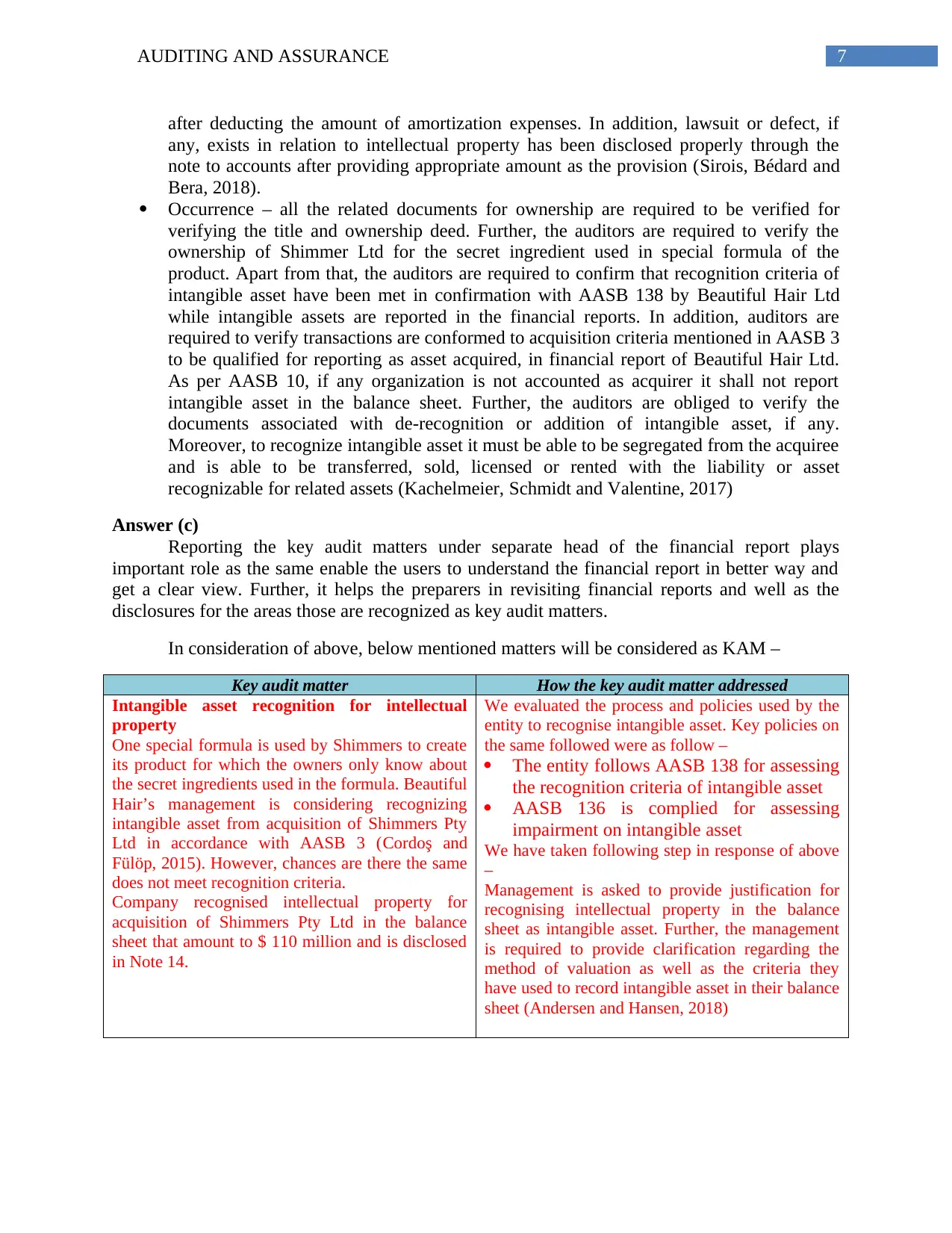
7AUDITING AND ASSURANCE
after deducting the amount of amortization expenses. In addition, lawsuit or defect, if
any, exists in relation to intellectual property has been disclosed properly through the
note to accounts after providing appropriate amount as the provision (Sirois, Bédard and
Bera, 2018).
Occurrence – all the related documents for ownership are required to be verified for
verifying the title and ownership deed. Further, the auditors are required to verify the
ownership of Shimmer Ltd for the secret ingredient used in special formula of the
product. Apart from that, the auditors are required to confirm that recognition criteria of
intangible asset have been met in confirmation with AASB 138 by Beautiful Hair Ltd
while intangible assets are reported in the financial reports. In addition, auditors are
required to verify transactions are conformed to acquisition criteria mentioned in AASB 3
to be qualified for reporting as asset acquired, in financial report of Beautiful Hair Ltd.
As per AASB 10, if any organization is not accounted as acquirer it shall not report
intangible asset in the balance sheet. Further, the auditors are obliged to verify the
documents associated with de-recognition or addition of intangible asset, if any.
Moreover, to recognize intangible asset it must be able to be segregated from the acquiree
and is able to be transferred, sold, licensed or rented with the liability or asset
recognizable for related assets (Kachelmeier, Schmidt and Valentine, 2017)
Answer (c)
Reporting the key audit matters under separate head of the financial report plays
important role as the same enable the users to understand the financial report in better way and
get a clear view. Further, it helps the preparers in revisiting financial reports and well as the
disclosures for the areas those are recognized as key audit matters.
In consideration of above, below mentioned matters will be considered as KAM –
Key audit matter How the key audit matter addressed
Intangible asset recognition for intellectual
property
One special formula is used by Shimmers to create
its product for which the owners only know about
the secret ingredients used in the formula. Beautiful
Hair’s management is considering recognizing
intangible asset from acquisition of Shimmers Pty
Ltd in accordance with AASB 3 (Cordoş and
Fülöp, 2015). However, chances are there the same
does not meet recognition criteria.
Company recognised intellectual property for
acquisition of Shimmers Pty Ltd in the balance
sheet that amount to $ 110 million and is disclosed
in Note 14.
We evaluated the process and policies used by the
entity to recognise intangible asset. Key policies on
the same followed were as follow –
The entity follows AASB 138 for assessing
the recognition criteria of intangible asset
AASB 136 is complied for assessing
impairment on intangible asset
We have taken following step in response of above
–
Management is asked to provide justification for
recognising intellectual property in the balance
sheet as intangible asset. Further, the management
is required to provide clarification regarding the
method of valuation as well as the criteria they
have used to record intangible asset in their balance
sheet (Andersen and Hansen, 2018)
after deducting the amount of amortization expenses. In addition, lawsuit or defect, if
any, exists in relation to intellectual property has been disclosed properly through the
note to accounts after providing appropriate amount as the provision (Sirois, Bédard and
Bera, 2018).
Occurrence – all the related documents for ownership are required to be verified for
verifying the title and ownership deed. Further, the auditors are required to verify the
ownership of Shimmer Ltd for the secret ingredient used in special formula of the
product. Apart from that, the auditors are required to confirm that recognition criteria of
intangible asset have been met in confirmation with AASB 138 by Beautiful Hair Ltd
while intangible assets are reported in the financial reports. In addition, auditors are
required to verify transactions are conformed to acquisition criteria mentioned in AASB 3
to be qualified for reporting as asset acquired, in financial report of Beautiful Hair Ltd.
As per AASB 10, if any organization is not accounted as acquirer it shall not report
intangible asset in the balance sheet. Further, the auditors are obliged to verify the
documents associated with de-recognition or addition of intangible asset, if any.
Moreover, to recognize intangible asset it must be able to be segregated from the acquiree
and is able to be transferred, sold, licensed or rented with the liability or asset
recognizable for related assets (Kachelmeier, Schmidt and Valentine, 2017)
Answer (c)
Reporting the key audit matters under separate head of the financial report plays
important role as the same enable the users to understand the financial report in better way and
get a clear view. Further, it helps the preparers in revisiting financial reports and well as the
disclosures for the areas those are recognized as key audit matters.
In consideration of above, below mentioned matters will be considered as KAM –
Key audit matter How the key audit matter addressed
Intangible asset recognition for intellectual
property
One special formula is used by Shimmers to create
its product for which the owners only know about
the secret ingredients used in the formula. Beautiful
Hair’s management is considering recognizing
intangible asset from acquisition of Shimmers Pty
Ltd in accordance with AASB 3 (Cordoş and
Fülöp, 2015). However, chances are there the same
does not meet recognition criteria.
Company recognised intellectual property for
acquisition of Shimmers Pty Ltd in the balance
sheet that amount to $ 110 million and is disclosed
in Note 14.
We evaluated the process and policies used by the
entity to recognise intangible asset. Key policies on
the same followed were as follow –
The entity follows AASB 138 for assessing
the recognition criteria of intangible asset
AASB 136 is complied for assessing
impairment on intangible asset
We have taken following step in response of above
–
Management is asked to provide justification for
recognising intellectual property in the balance
sheet as intangible asset. Further, the management
is required to provide clarification regarding the
method of valuation as well as the criteria they
have used to record intangible asset in their balance
sheet (Andersen and Hansen, 2018)
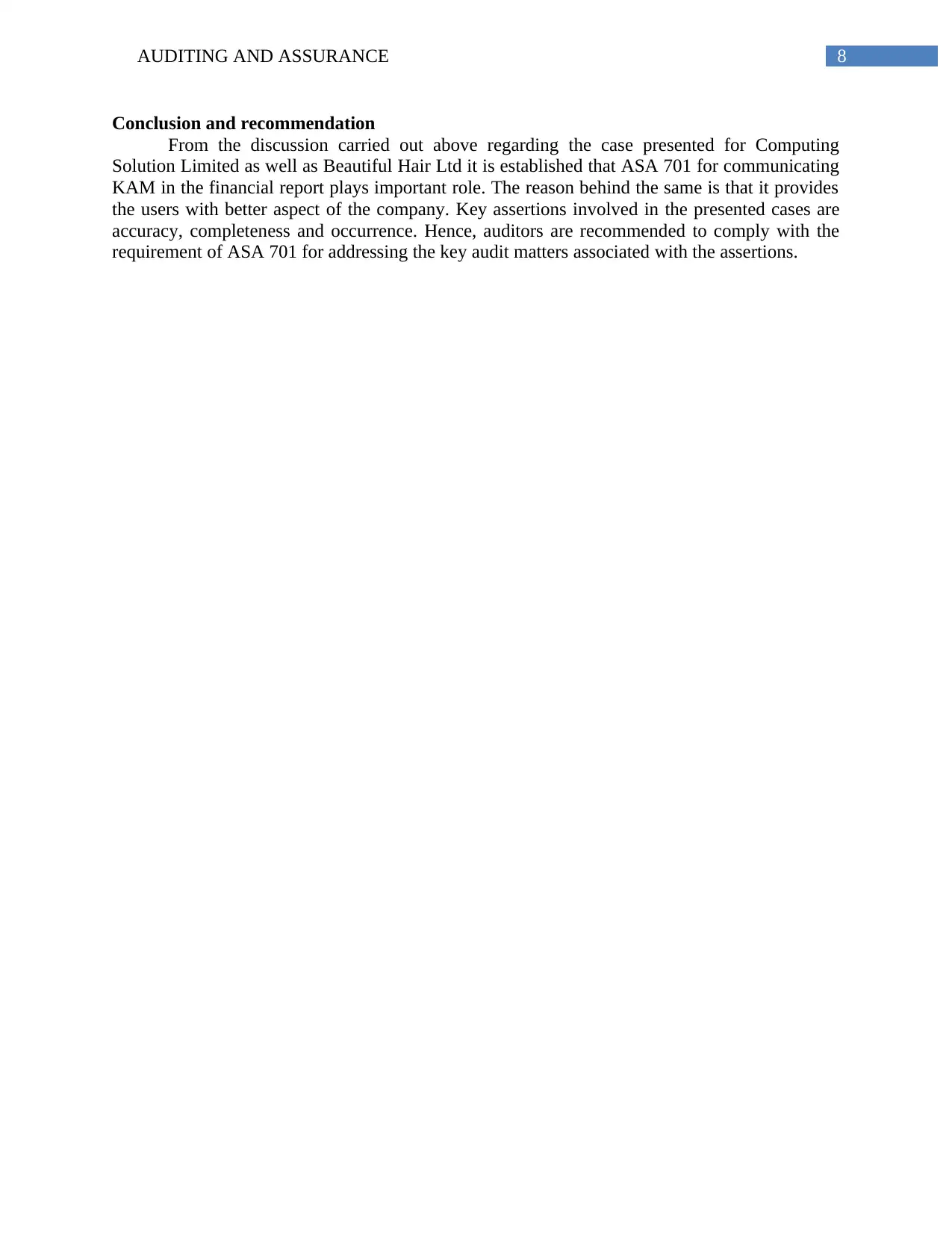
8AUDITING AND ASSURANCE
Conclusion and recommendation
From the discussion carried out above regarding the case presented for Computing
Solution Limited as well as Beautiful Hair Ltd it is established that ASA 701 for communicating
KAM in the financial report plays important role. The reason behind the same is that it provides
the users with better aspect of the company. Key assertions involved in the presented cases are
accuracy, completeness and occurrence. Hence, auditors are recommended to comply with the
requirement of ASA 701 for addressing the key audit matters associated with the assertions.
Conclusion and recommendation
From the discussion carried out above regarding the case presented for Computing
Solution Limited as well as Beautiful Hair Ltd it is established that ASA 701 for communicating
KAM in the financial report plays important role. The reason behind the same is that it provides
the users with better aspect of the company. Key assertions involved in the presented cases are
accuracy, completeness and occurrence. Hence, auditors are recommended to comply with the
requirement of ASA 701 for addressing the key audit matters associated with the assertions.
⊘ This is a preview!⊘
Do you want full access?
Subscribe today to unlock all pages.

Trusted by 1+ million students worldwide
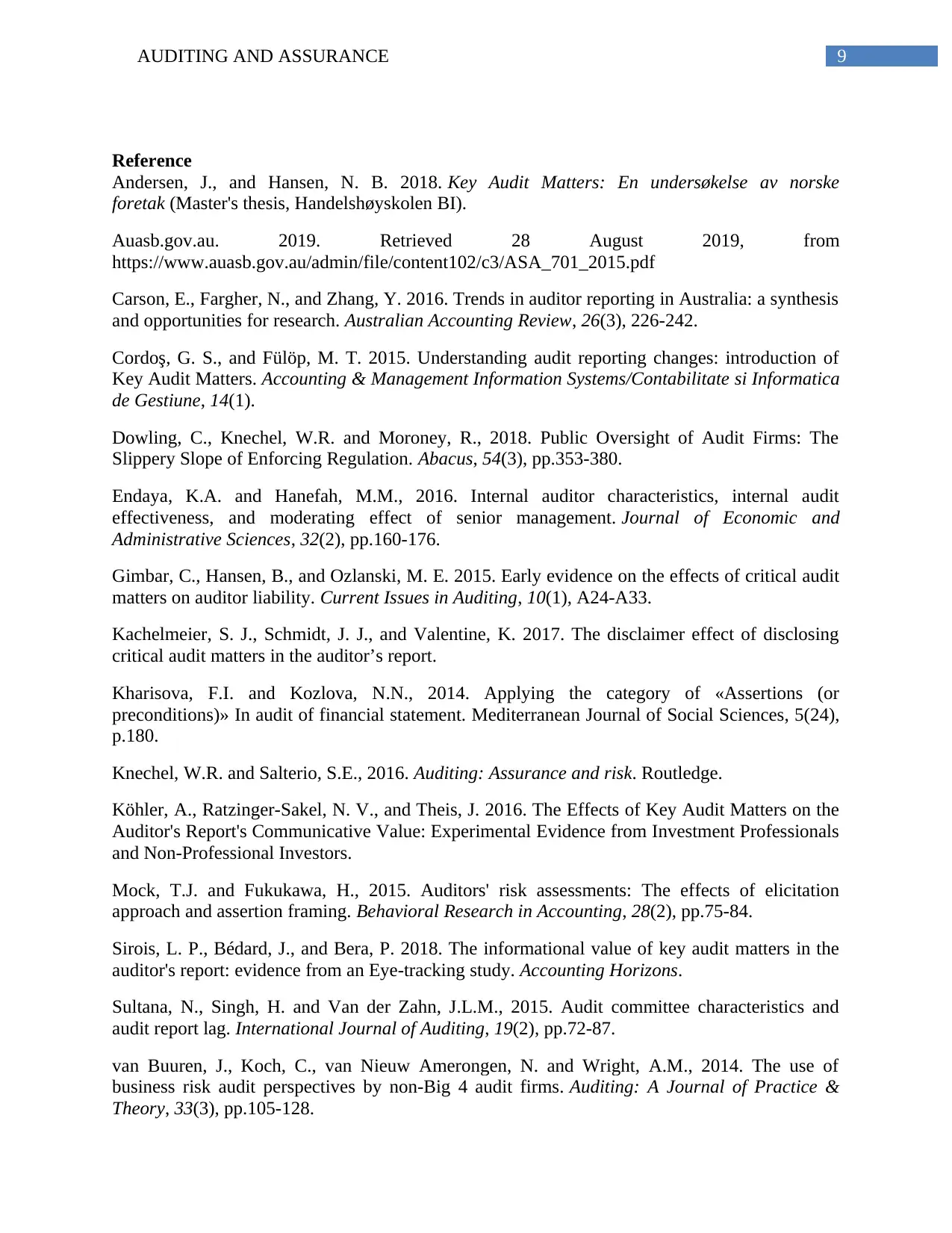
9AUDITING AND ASSURANCE
Reference
Andersen, J., and Hansen, N. B. 2018. Key Audit Matters: En undersøkelse av norske
foretak (Master's thesis, Handelshøyskolen BI).
Auasb.gov.au. 2019. Retrieved 28 August 2019, from
https://www.auasb.gov.au/admin/file/content102/c3/ASA_701_2015.pdf
Carson, E., Fargher, N., and Zhang, Y. 2016. Trends in auditor reporting in Australia: a synthesis
and opportunities for research. Australian Accounting Review, 26(3), 226-242.
Cordoş, G. S., and Fülöp, M. T. 2015. Understanding audit reporting changes: introduction of
Key Audit Matters. Accounting & Management Information Systems/Contabilitate si Informatica
de Gestiune, 14(1).
Dowling, C., Knechel, W.R. and Moroney, R., 2018. Public Oversight of Audit Firms: The
Slippery Slope of Enforcing Regulation. Abacus, 54(3), pp.353-380.
Endaya, K.A. and Hanefah, M.M., 2016. Internal auditor characteristics, internal audit
effectiveness, and moderating effect of senior management. Journal of Economic and
Administrative Sciences, 32(2), pp.160-176.
Gimbar, C., Hansen, B., and Ozlanski, M. E. 2015. Early evidence on the effects of critical audit
matters on auditor liability. Current Issues in Auditing, 10(1), A24-A33.
Kachelmeier, S. J., Schmidt, J. J., and Valentine, K. 2017. The disclaimer effect of disclosing
critical audit matters in the auditor’s report.
Kharisova, F.I. and Kozlova, N.N., 2014. Applying the category of «Assertions (or
preconditions)» In audit of financial statement. Mediterranean Journal of Social Sciences, 5(24),
p.180.
Knechel, W.R. and Salterio, S.E., 2016. Auditing: Assurance and risk. Routledge.
Köhler, A., Ratzinger-Sakel, N. V., and Theis, J. 2016. The Effects of Key Audit Matters on the
Auditor's Report's Communicative Value: Experimental Evidence from Investment Professionals
and Non-Professional Investors.
Mock, T.J. and Fukukawa, H., 2015. Auditors' risk assessments: The effects of elicitation
approach and assertion framing. Behavioral Research in Accounting, 28(2), pp.75-84.
Sirois, L. P., Bédard, J., and Bera, P. 2018. The informational value of key audit matters in the
auditor's report: evidence from an Eye-tracking study. Accounting Horizons.
Sultana, N., Singh, H. and Van der Zahn, J.L.M., 2015. Audit committee characteristics and
audit report lag. International Journal of Auditing, 19(2), pp.72-87.
van Buuren, J., Koch, C., van Nieuw Amerongen, N. and Wright, A.M., 2014. The use of
business risk audit perspectives by non-Big 4 audit firms. Auditing: A Journal of Practice &
Theory, 33(3), pp.105-128.
Reference
Andersen, J., and Hansen, N. B. 2018. Key Audit Matters: En undersøkelse av norske
foretak (Master's thesis, Handelshøyskolen BI).
Auasb.gov.au. 2019. Retrieved 28 August 2019, from
https://www.auasb.gov.au/admin/file/content102/c3/ASA_701_2015.pdf
Carson, E., Fargher, N., and Zhang, Y. 2016. Trends in auditor reporting in Australia: a synthesis
and opportunities for research. Australian Accounting Review, 26(3), 226-242.
Cordoş, G. S., and Fülöp, M. T. 2015. Understanding audit reporting changes: introduction of
Key Audit Matters. Accounting & Management Information Systems/Contabilitate si Informatica
de Gestiune, 14(1).
Dowling, C., Knechel, W.R. and Moroney, R., 2018. Public Oversight of Audit Firms: The
Slippery Slope of Enforcing Regulation. Abacus, 54(3), pp.353-380.
Endaya, K.A. and Hanefah, M.M., 2016. Internal auditor characteristics, internal audit
effectiveness, and moderating effect of senior management. Journal of Economic and
Administrative Sciences, 32(2), pp.160-176.
Gimbar, C., Hansen, B., and Ozlanski, M. E. 2015. Early evidence on the effects of critical audit
matters on auditor liability. Current Issues in Auditing, 10(1), A24-A33.
Kachelmeier, S. J., Schmidt, J. J., and Valentine, K. 2017. The disclaimer effect of disclosing
critical audit matters in the auditor’s report.
Kharisova, F.I. and Kozlova, N.N., 2014. Applying the category of «Assertions (or
preconditions)» In audit of financial statement. Mediterranean Journal of Social Sciences, 5(24),
p.180.
Knechel, W.R. and Salterio, S.E., 2016. Auditing: Assurance and risk. Routledge.
Köhler, A., Ratzinger-Sakel, N. V., and Theis, J. 2016. The Effects of Key Audit Matters on the
Auditor's Report's Communicative Value: Experimental Evidence from Investment Professionals
and Non-Professional Investors.
Mock, T.J. and Fukukawa, H., 2015. Auditors' risk assessments: The effects of elicitation
approach and assertion framing. Behavioral Research in Accounting, 28(2), pp.75-84.
Sirois, L. P., Bédard, J., and Bera, P. 2018. The informational value of key audit matters in the
auditor's report: evidence from an Eye-tracking study. Accounting Horizons.
Sultana, N., Singh, H. and Van der Zahn, J.L.M., 2015. Audit committee characteristics and
audit report lag. International Journal of Auditing, 19(2), pp.72-87.
van Buuren, J., Koch, C., van Nieuw Amerongen, N. and Wright, A.M., 2014. The use of
business risk audit perspectives by non-Big 4 audit firms. Auditing: A Journal of Practice &
Theory, 33(3), pp.105-128.
Paraphrase This Document
Need a fresh take? Get an instant paraphrase of this document with our AI Paraphraser
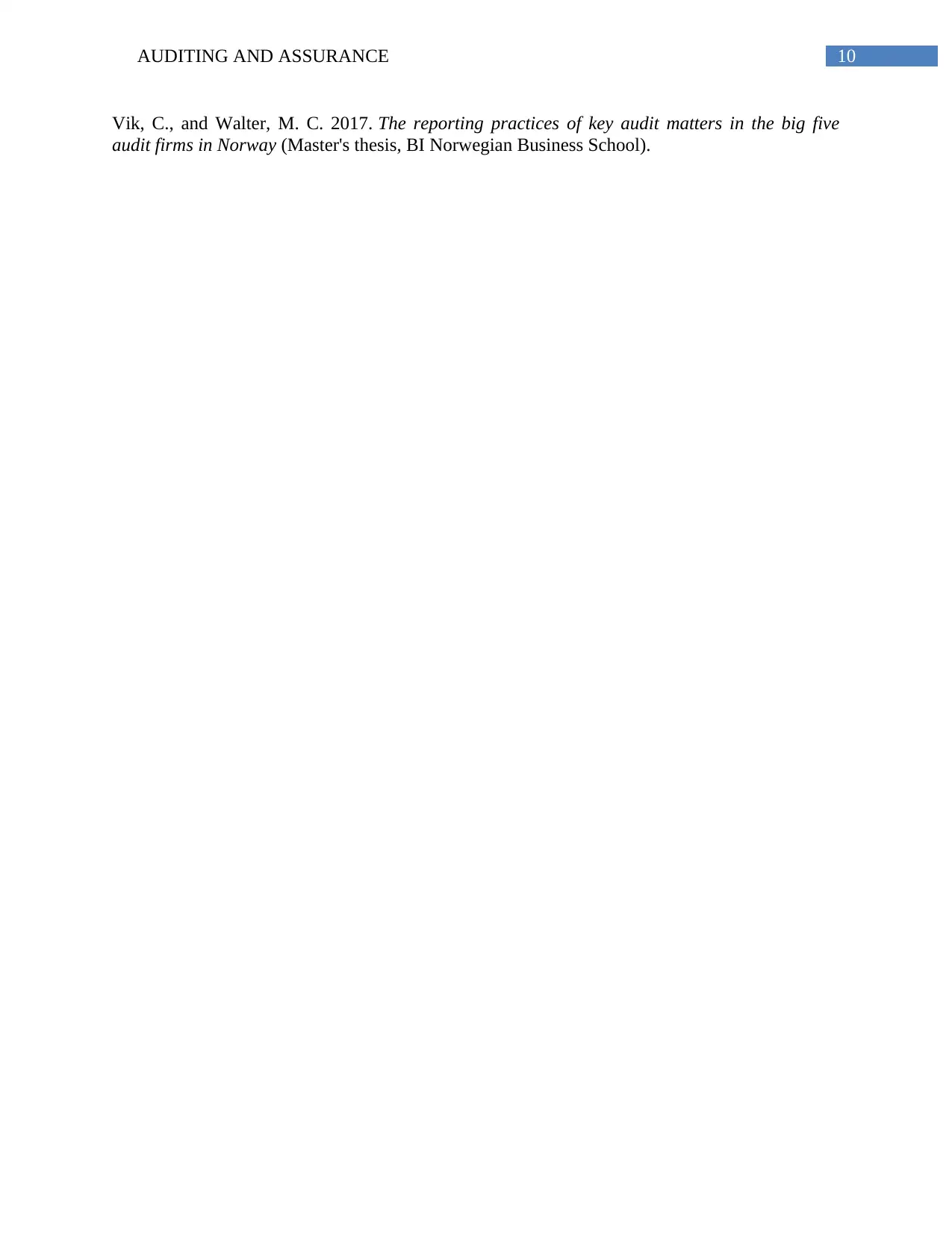
10AUDITING AND ASSURANCE
Vik, C., and Walter, M. C. 2017. The reporting practices of key audit matters in the big five
audit firms in Norway (Master's thesis, BI Norwegian Business School).
Vik, C., and Walter, M. C. 2017. The reporting practices of key audit matters in the big five
audit firms in Norway (Master's thesis, BI Norwegian Business School).
1 out of 11
Related Documents
Your All-in-One AI-Powered Toolkit for Academic Success.
+13062052269
info@desklib.com
Available 24*7 on WhatsApp / Email
![[object Object]](/_next/static/media/star-bottom.7253800d.svg)
Unlock your academic potential
Copyright © 2020–2025 A2Z Services. All Rights Reserved. Developed and managed by ZUCOL.





